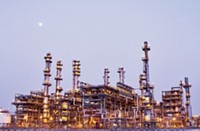Advertisement
Grab your lab coat. Let's get started
Welcome!
Welcome!
Create an account below to get 6 C&EN articles per month, receive newsletters and more - all free.
It seems this is your first time logging in online. Please enter the following information to continue.
As an ACS member you automatically get access to this site. All we need is few more details to create your reading experience.
Not you? Sign in with a different account.
Not you? Sign in with a different account.
ERROR 1
ERROR 1
ERROR 2
ERROR 2
ERROR 2
ERROR 2
ERROR 2
Password and Confirm password must match.
If you have an ACS member number, please enter it here so we can link this account to your membership. (optional)
ERROR 2
ACS values your privacy. By submitting your information, you are gaining access to C&EN and subscribing to our weekly newsletter. We use the information you provide to make your reading experience better, and we will never sell your data to third party members.
Business
Middle East: After Years Of Growth, A Profits Squeeze Lies Ahead
by Alex Scott
January 14, 2013
| A version of this story appeared in
Volume 91, Issue 2

The depressed economic situation in Europe, a key market for chemicals from the Middle East, is having a negative impact on the region’s chemical producers. Europe’s reduced need for polyethylene, ethylene glycol, fertilizers, and other chemicals has redirected Middle East exports to China. But in that country they fetch lower prices, says Paul Bjacek, head of research for chemicals and natural resources at the consulting firm Accenture.
Another problem is the ethane shortfall, caused by high demand from the region’s power generators and petrochemical producers. Without a ready supply, Bjacek says, newer companies are instead turning to refinery-derived naphtha as a raw material. They are using it to build up their capacity for aromatics and other chemicals with more than two carbon atoms, including butadiene, propylene, and propylene derivatives.
To ease their heavy reliance on profit from basic petrochemicals and polymers, the region’s leading chemical companies also will continue their policy of diversification into specialty chemicals, says Tony Potter, an analyst with IHS Chemical.
Saudi Basic Industries Corp. is among the region’s leading companies in both profitability and product diversification. SABIC CEO Mohamed H. Al-Mady told delegates at a Gulf Petrochemicals & Chemicals Association meeting in Dubai late last year that the industry’s future now has more to do with technology and innovation than feedstock price.
“We need to direct our efforts toward offering our customers more technologically advanced and complex products,” he said.
A recent agreement between the carmaker Jaguar Land Rover and the government of Saudi Arabia to study plans for an automobile factory in the country indicates the level of industrial diversification that the region aims to achieve, Potter says. Change is happening, he adds, but it is “generally quite a slow process.”
MORE ON THIS STORY
- - World Chemical Outlook
- - Pharmaceuticals: Companies Will Focus On External Partnerships To Improve Productivity
- - U.S.: Domestic Manufacturing Slowdown Will Be Offset By Shale Gas Upside
- - Construction: The Action, Once Again, Is In Developing Countries
- - Europe: Economy And Chemical Industry Are Expected To Stagnate
- - Fine Chemicals: Optimism Prevails Over Uncertainty
- - Asia: Slowdown In China, Although Mild, Is Cause For Concern
- - Petrochemicals: The U.S. Will See A Boom As Europe And Asia Struggle
- - Cleantech: New Funding Will Be Scarce, But Scale-Up Plans Continue
- - Specialties: Growth To Be Fueled By Autos, Electronics
- - Canada: After A So-So 2012, Chemical Firms Prepare For A Brighter Future
- - Instrumentation: Firms Plan For The Long Term Amid Short-Term Uncertainties
- - Middle East: After Years Of Growth, A Profits Squeeze Lies Ahead
- - Advanced Materials: Carbon Fiber, 3-D Printing, Graphene To Make Inroads
- - Latin America: Policymakers, Industry Seek To Boost Competition



Join the conversation
Contact the reporter
Submit a Letter to the Editor for publication
Engage with us on Twitter